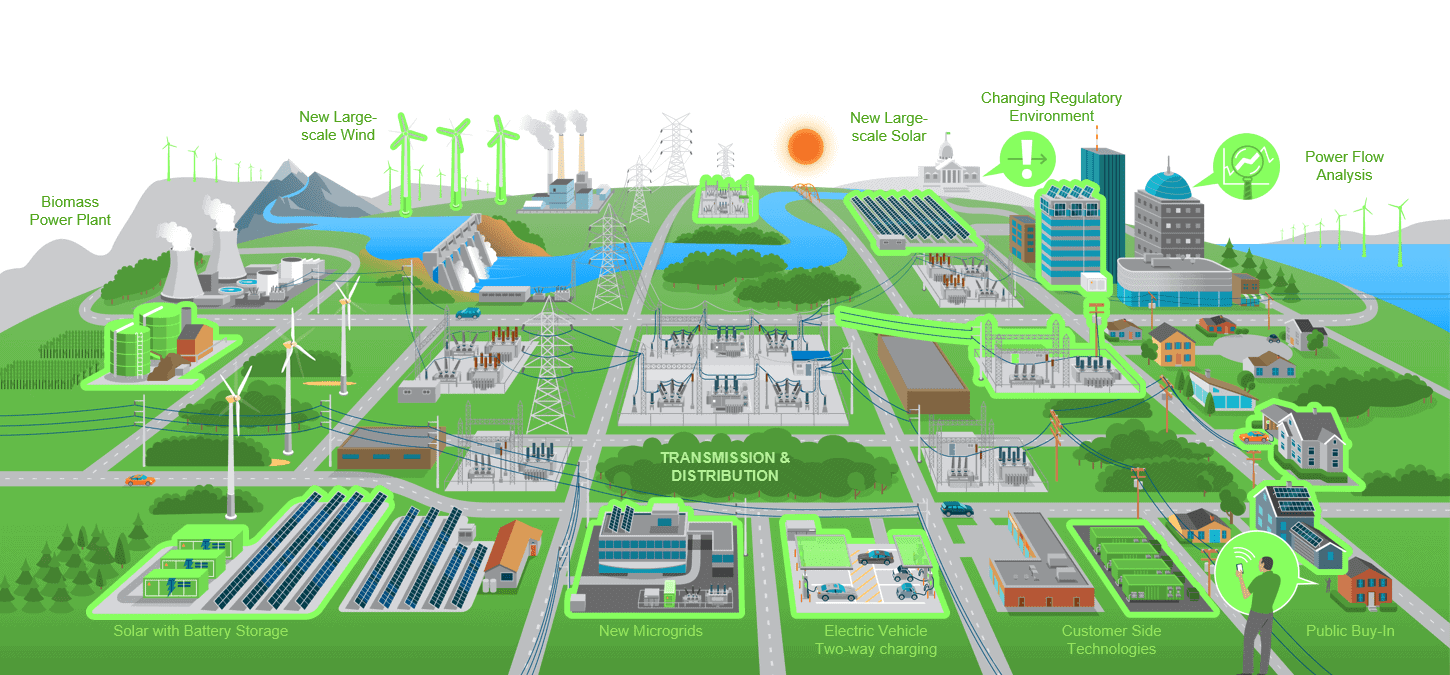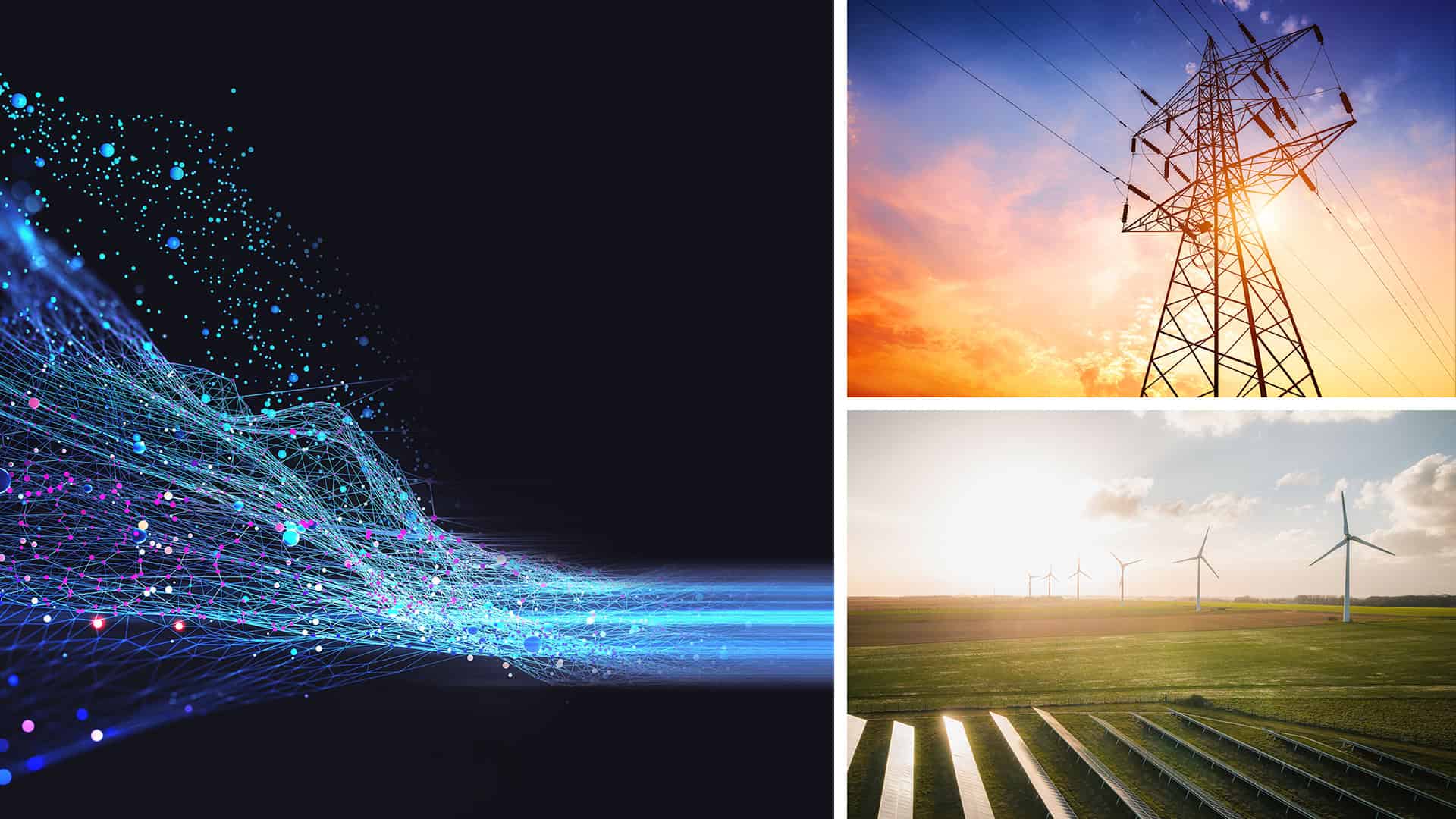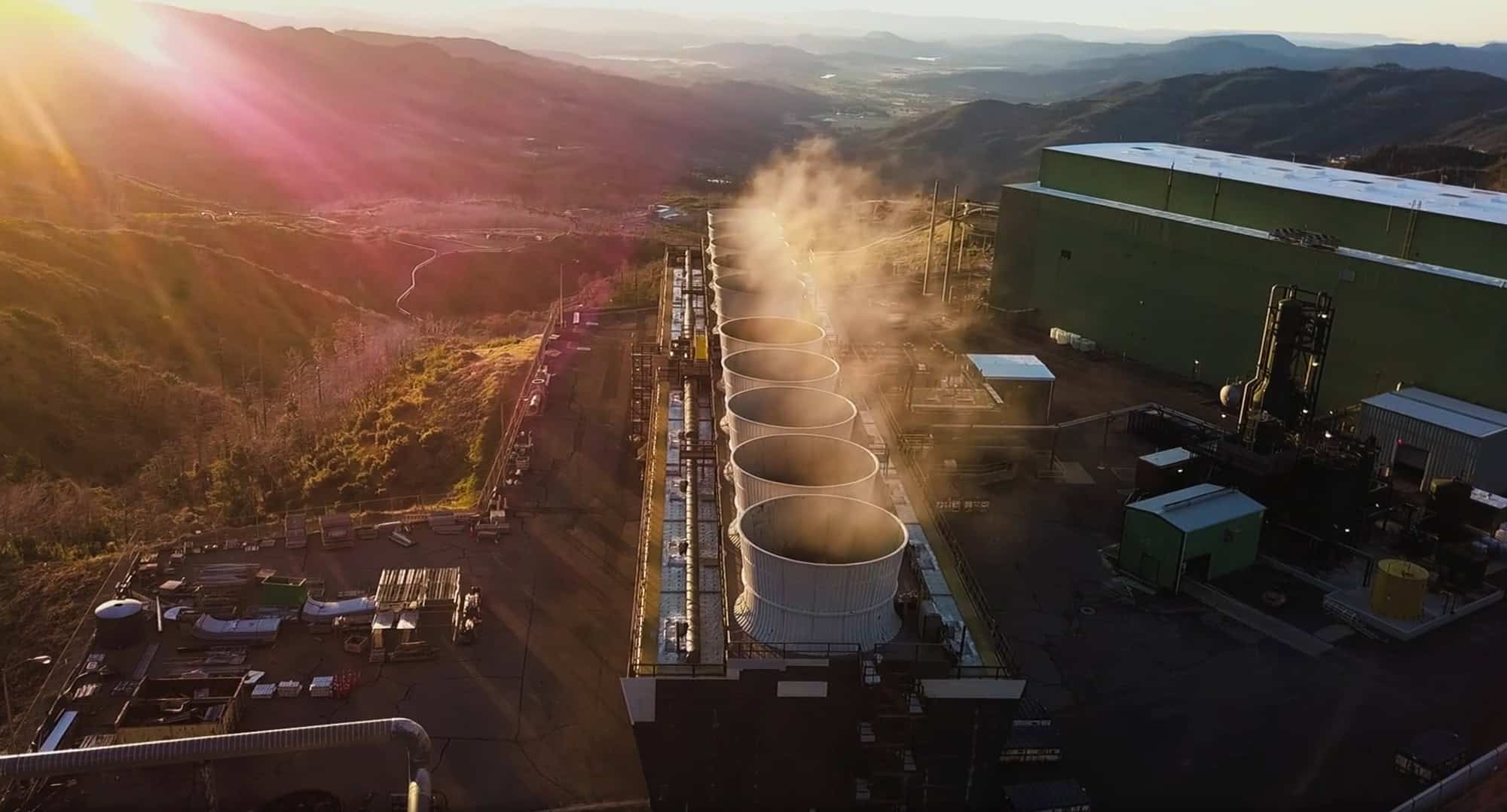Extreme weather, vegetation encroachment, regulatory pressures, and distributed energy resources (DER) integration are just a few examples of the countless challenges facing electric utilities. Aging equipment and infrastructure, unpredictable and shifting electricity demands, cybersecurity threats, and decarbonization pressures add to the list.
Utilities face internal challenges as well, particularly when it comes to managing, understanding, and analyzing the vast amounts of data related with today’s complex energy grids. And the success of digitalization efforts has only added to that data overload. With these challenges, power reliability can be affected, and customers may seek to develop their own energy sources. When this happens, it threatens the relevance of the utility and revenues.
One valuable tool helping utilities meet these challenges is the use of a digital twin to provide a comprehensive view of grid data and operations for more accurate, informed decisions. With digital twins, utilities can optimize their grid reliability and resilience, and help them usher in a new carbon-neutral future.
About Digital Twins
A digital twin is a virtual representation of a physical asset, process or system, as well as the underlying engineering information. For an electrical grid, this can include generation, transmission, and distribution assets. This virtual environment is built upon and updated by multiple information sources, such as GIS, engineering, and maintenance data, as well as operational SCADA data feeds from sensors, meters, and so on.
In addition, sophisticated engineering, analysis, and decision-support tools can be built into the digital twin. By going beyond mere IT/OT convergence, the integration of engineering information and technology enables utilities to fully exploit their data—giving them new operational analytics and insights.
The consolidated, connected digital twin environment provides a unified view of a grid’s current performance (as well as a definitive record of its past performance). A visual, intuitive user interface provides easy access to data. Open connectivity to disparate data and systems give access to what had been isolated legacy data and systems. All of this provides valuable insight into the health of the grid for proactive asset planning, management, and operations.
Digital twins allow utilities to understand and model their grid’s performance and plan for the entire lifecycle of grid assets. They enable controlled access to all the information utilities need to analyze and monitor what’s happening across their entire grid operation and proactively mitigate the potential risks and threats. They enable sustainable grid reliability and resilience, intelligent grid design, increased project efficiency, and smooth integration of renewables to advance grid modernization.
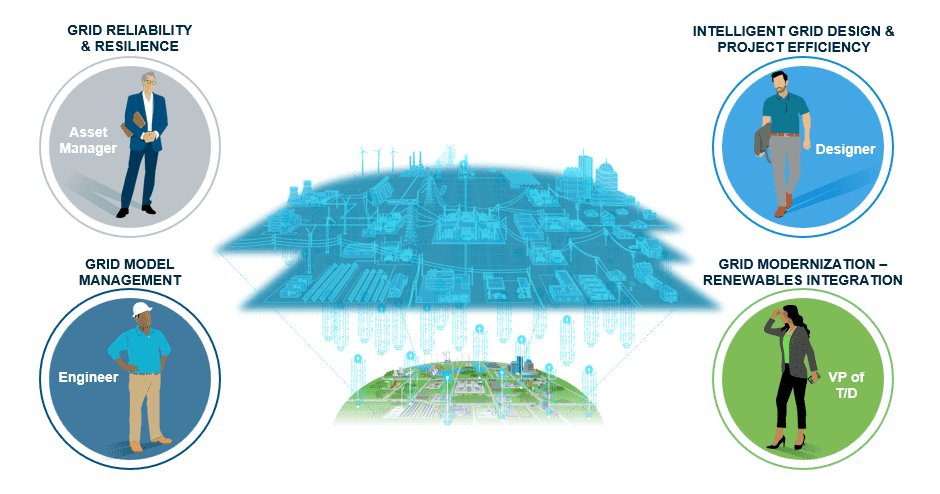 How can the digital twin help you? Digital twins provide valuable insight into the health of the grid for proactive asset planning management and operations.
How can the digital twin help you? Digital twins provide valuable insight into the health of the grid for proactive asset planning management and operations.Grid Reliability and Resilience
A digital twin can be a utility’s mainstay of grid reliability and resilience. It provides a visual window into overall grid operations, including performance, network anomalies, feedback from analytics, and up-to-date change history. And by combining data and connecting it to other systems (such as GIS, simulation tools, and asset management), the twin becomes a utility’s single ‘view of truth’. For instance, a digital twin might flag a potential issue in the network before it becomes a crisis, such as adding too much capacity to an existing substation, visually highlighting which part of the network would be affected, allowing operators and engineers to see what is approaching overloaded and take corrective action as needed.
The digital twin’s connective link between the physical grid model, the operational and engineering data, and engineering simulation tools also gives utilities actionable insight into their grid. This insight enables them to react quickly to needs in the physical grid, helping them control the operational life of critical assets and mitigate operational risks, transmission and distribution losses, and system failures
For example, integrated predictive analytics improve asset reliability with proactive maintenance, risk management strategies, and decision support. A routine log might alert a maintenance worker that the most recent oil analysis for a specific transformer continues to display unusual degradation, prompting a closer look at the electrical SCADA data that shows that indeed the transformer is being regularly overloaded. These analytics portray the overall health and longevity of the transformer and allow the utility to take action before its failure.
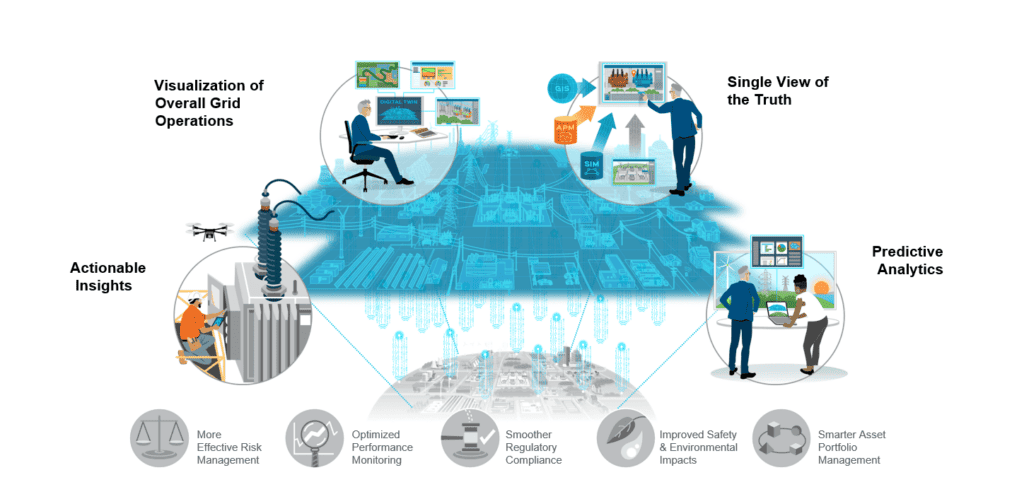 Grid reliability and resilience: By consolidating and validating data from disparate systems, Grid Digital Twins help Transmission and Distribution operators deliver more reliable service with an improved ability to proactively optimize operations through a coherent, single, near real-time view of the grid.
Grid reliability and resilience: By consolidating and validating data from disparate systems, Grid Digital Twins help Transmission and Distribution operators deliver more reliable service with an improved ability to proactively optimize operations through a coherent, single, near real-time view of the grid.Grid Design and Project Efficiency
The life of a digital twin doesn’t necessarily start with operations. It can also be central to a utility’s design efforts. Obviously, for grid modifications and expansions, the real-time digital twin being used for operations can easily be repurposed as the basis of design to jump-start the whole design process and help ensure the accuracy of ‘as-is’ existing conditions.
But a digital twin can also be used for a greenfield design project, where the first incarnation of the digital twin may be (for example) a single line distribution diagram, combined with a physical model of the project’s existing context such as maps and GIS information. Designers can then add electrical designs, protection controls, and so on. Integrated engineering analysis software can be used to optimize steady-state operating conditions or analyze how the emerging design handles unforeseen operating conditions and failures. As the design progresses, different stakeholders, departments, and engineering firms can collaborate using a cloud-based digital twin for greater design efficiency and fidelity.
As more engineering depth and details are added throughout the design process, dynamic 4D modeling captures an ongoing authoritative record of the developing design. Every physical or engineering change is stored within the digital twin, allowing utilities to understand how their grid changed throughout design, construction, and operations—providing critical historical data and facilitating standard business processes such as design reviews.
Moreover, the underlying engineering intent and specifications are automatically attached to the digital twin—information that will be vital for future operations and maintenance. Utilities can continue to maximize efficiencies when the project moves beyond the design phase. For example, during construction, the placement of underground utilities can be recorded in the digital twin for future reference.
Integration of Renewables
In this era of DERs, utilities are using digital twins for rapid, data-based decision-making regarding DER interconnections. Digital twins, with their built-in analytical tools, can help utilities gain a more detailed understanding of the operational impacts of DER interconnections.
By virtually adding the new energy sources and interconnections, utilities can use the digital twin as their testing ground. They can perform what-if analyses to weigh the impacts of a proposed DER connection against proposed decarbonization plans before a new renewable energy source is added to the grid.
For example, utilities can use the digital twin to conduct power flow analysis to model the current grid and then the grid with the proposed DER connection. These simulations can accelerate and improve the assessment of a DER interconnection request, allowing teams to easily accomplish their technical due diligence and determine if further engineering analysis and studies are necessary. Moreover, digital twins can also enhance efficiency and productivity by enabling non-engineers and managers to effectively manage DER interconnection applications while still adhering to standardized regulatory requirements for DER permits.
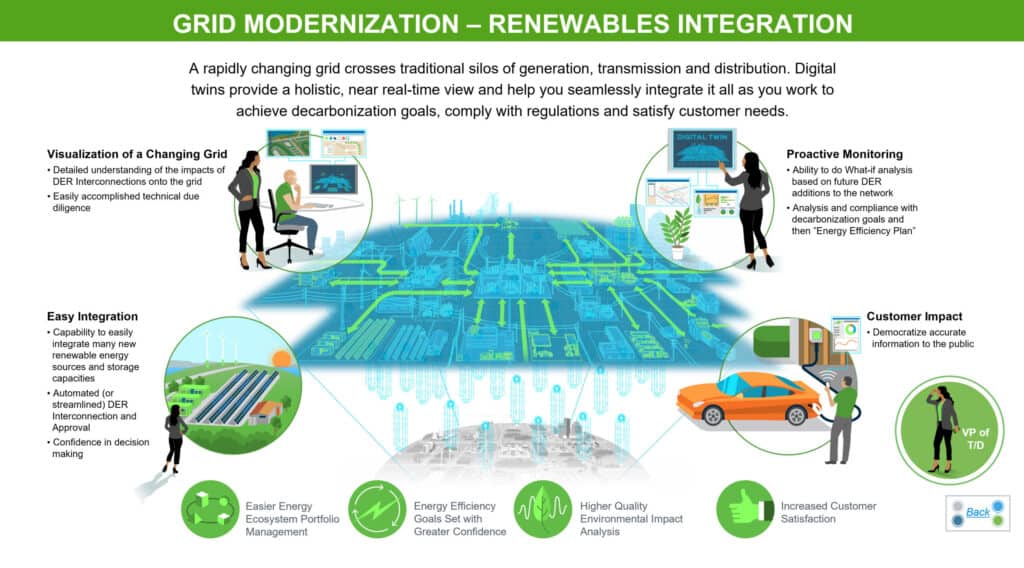 Grid modernization and renewables integration: A rapidly changing grid crosses traditional silos of generation, transmission and distribution. Digital twins provide a holistic, near real-time view and help you seamlessly integrate it all as you work to achieve decarbonization goals, comply with regulations and satisfy customer needs.
Grid modernization and renewables integration: A rapidly changing grid crosses traditional silos of generation, transmission and distribution. Digital twins provide a holistic, near real-time view and help you seamlessly integrate it all as you work to achieve decarbonization goals, comply with regulations and satisfy customer needs.Digital Twins are the Future for a Sustainable Grid
Increasingly, digital twins are giving utilities data-rich insights into their rapidly transforming energy grids—helping them make prompt and informed decisions to improve their grid’s safety, reliability, and resilience. Increasingly, digital twins are giving utilities data-rich insights into their rapidly transforming energy grids—helping them make prompt and informed decisions to improve their grid’s safety, reliability, and resilience. Stadtwerke Schwäbisch Hall in Germany are a great example of an early adopter of digital technology to integrate their network and renewable generation – see page 14 of this eBook. By 2030, Stadtwerke Schwäbisch Hall wants to convert electricity generation in the region to 100% renewable energy.
With digital twins, utilities can more easily manage their energy ecosystems to reach their energy efficiency and environmental stewardship goals, while satisfying their customers and stakeholders.

